Welcome to the captivating world of Collage Art Techniques where you can transform your artwork using mixed media. With our expert guidance, whether you are a beginner or experienced artist, you will learn to master the art of collage and create beautiful pieces that express your unique style and creativity. Discover new techniques, explore different materials, and learn how to add textures, colors, and typography to your artwork to bring it to life.
- Collage art involves combining different materials to create a unique visual composition.
- Collage techniques can range from traditional cut-and-paste methods to more experimental approaches.
- Composition, layout, texture, and color theory are vital elements in creating visually pleasing collages.
- Collage art allows you to incorporate found objects and mix different mediums for infinite creative possibilities.
- Proper display and preservation methods are essential to ensure your artwork remains in pristine condition.
What is Collage Art?
If you’re new to collage art, you may be wondering what it actually is. In essence, collage art involves combining various materials, such as photographs, magazine cutouts, fabric, and found objects, to create a unique visual composition. It’s a form of mixed media that allows you to experiment and express your creativity in new and exciting ways.
Whether you’re a seasoned artist or just starting out, collage art can provide endless creative possibilities. By combining different materials, you can explore new textures, colors, and styles, and push the boundaries of traditional art forms.
So what is mixed media art? It’s simply the combination of two or more art forms, such as painting and sculpture, or, in the case of collage art, using various materials to create a cohesive whole.
Collage art is a unique and exciting form of mixed media, allowing artists to explore their creativity and express themselves in dynamic new ways.
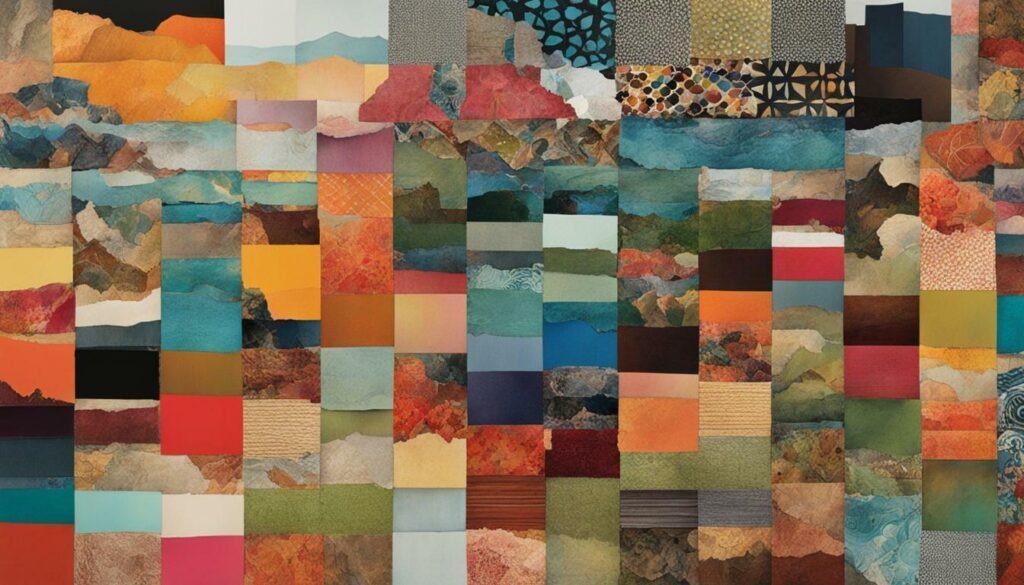
- Collage art combines different materials, such as photographs, fabric, and found objects, to create a unique visual composition.
- Mixed media art is the combination of two or more art forms to create a cohesive whole.
- Collage art allows artists to push the boundaries of traditional art forms and explore new textures, colors, and styles.
Essential Tools for Collage Art
Collage art requires several tools and supplies to bring your creative ideas to life. Most of these supplies can be found at any local arts and crafts store or online. Below are some of the essential tools and materials you need to have:
- Scissors: A good pair of scissors is essential for cutting and trimming your materials. Ensure they are sharp and easy to handle.
- Glue or Adhesive: Use a reliable adhesive to attach your materials to your artwork. Choose an adhesive that dries clear and won’t wrinkle or warp your paper.
- Cutting mat: A self-healing cutting mat provides a safe and smooth surface for cutting and trimming your materials. It protects your work area and prolongs the life of your blades.
- Papers and Fabrics: Different types of papers and fabrics add depth and texture to your collage. Experiment with different textures, colors, and patterns to create your desired effect.
- Found Objects: These can include items such as buttons, feathers, old jewelry, and other small objects that can add a unique element to your artwork.

Having these supplies readily available will help you to create your collage art seamlessly. You can also incorporate other items specific to your work. These materials will allow you to experiment and create unique artwork in your personal style.
Exploring Different Techniques
Collage art offers endless possibilities for artistic expression. Whether you prefer a traditional cut-and-paste method or a more experimental approach, there are several techniques you can use to create unique and captivating collages. Here are some popular techniques that you can try:
- Layering: Using different materials and textures to create a layered effect
- Decoupage: Applying paper cutouts to a surface and coating them with varnish
- Photo transfers: Transferring images onto a surface using a transfer medium
- Digital manipulation: Combining traditional and digital methods to create collages
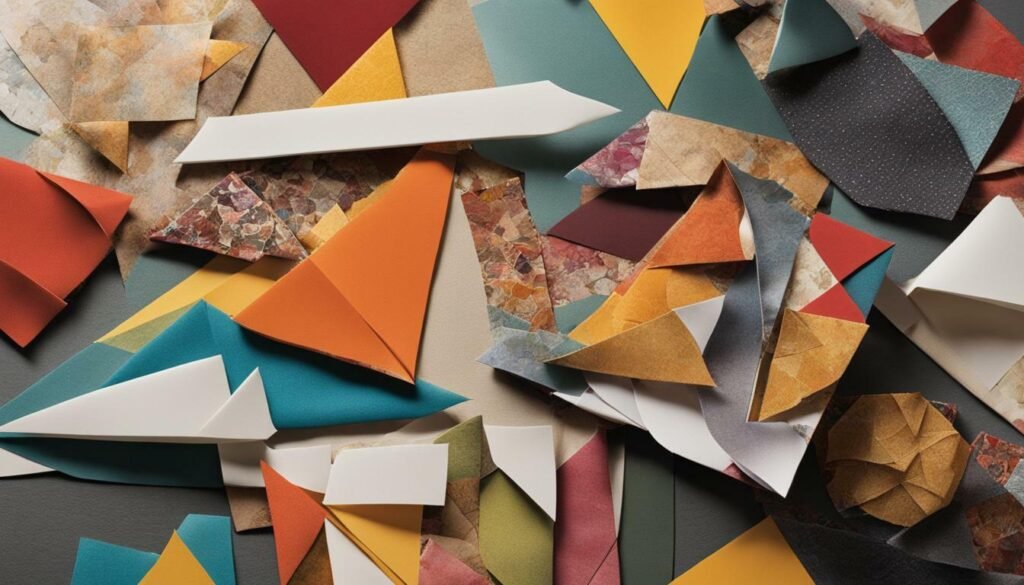
Experimenting with different techniques allows you to discover your personal style and push your artistic boundaries. Don’t be afraid to try something new and explore your creativity!
Composition and Layout Tips
Creating a visually appealing collage requires careful attention to composition and layout. Here are some tips to help you achieve a harmonious design:
- Start by selecting a focal point for your collage and build around it.
- Experiment with different arrangements before settling on a final composition.
- Use a variety of shapes, sizes, and colors to create visual interest.
- Consider the negative space – the areas without collage elements – and use it to enhance the composition’s balance.
- Pay attention to visual weight and balance elements throughout the composition.
Remember that there are no hard and fast rules – the best design is one that feels right to you. Trust your instincts and your unique style.
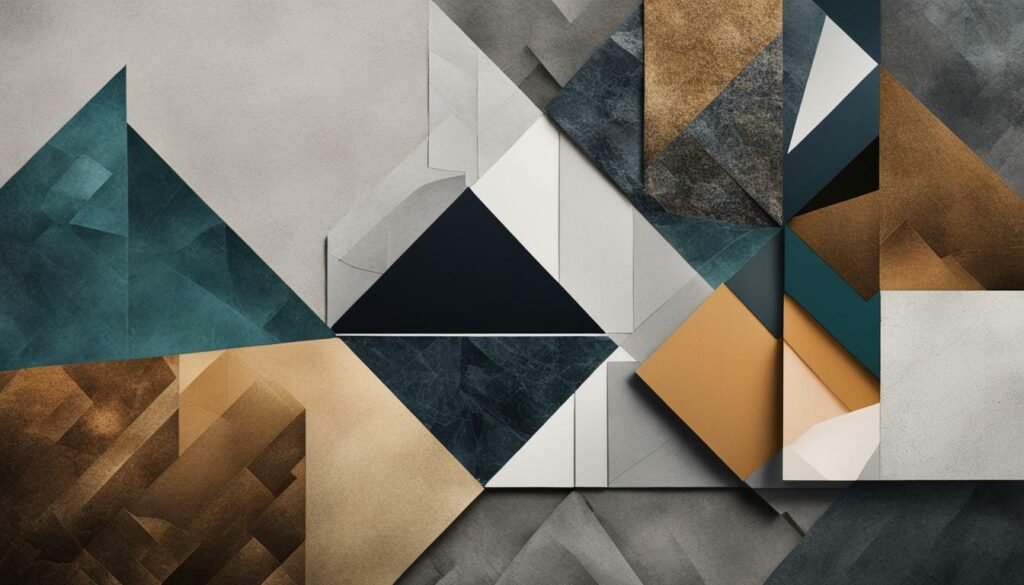
Texture and dimension are essential elements of collage art that can add depth and interest to your composition. Here are some mixed media techniques to experiment with:
- Use fabric and thread to create tactile elements that add a new dimension to your collage.
- Create layers by incorporating different types of paper, such as tissue paper or handmade paper.
- Add texture to your background using stencils, stamps, or textured mediums like gesso or modeling paste.
- Embellish your collage with found objects like buttons, beads, or natural materials like leaves and twigs.
By incorporating these techniques, you can create a visual experience that engages the viewer’s sense of touch and adds a new layer of meaning to your artwork.
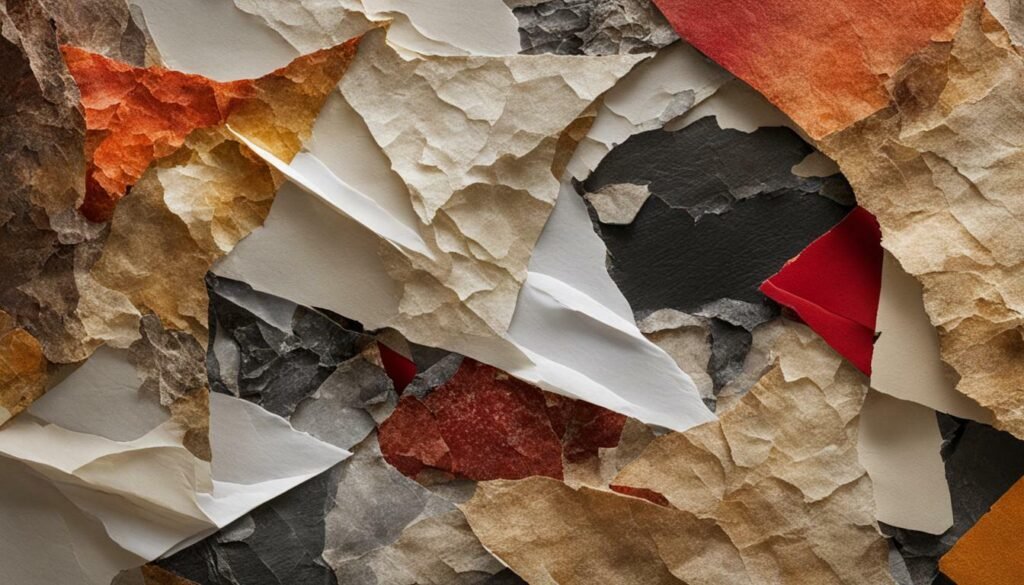
When you’re working with mixed media, it’s important to consider the materials you’re using and how they interact with one another. Experiment with different textures and layers to find a balance that feels right for your piece. With a little practice, you’ll find that adding texture and dimension can take your collage art to a whole new level.
Color Theory in Collage Art
Color is a powerful element that can greatly impact the mood and expression of your collage art. Here are some tips on how to use color effectively:
- Start with a color palette: Choose a set of colors that will guide your composition. A well-chosen color palette can create harmony and balance in your artwork.
- Experiment with color combinations: Try using complementary or analogous colors to create contrast and visual interest.
- Consider color psychology: Different colors can evoke different emotions or moods. For example, warm colors like red and orange can convey energy and passion, while cool colors like blue and green can evoke calm and tranquility.
By understanding the fundamentals of color theory, you can create visually impactful collages that convey your message and style. Don’t underestimate the power of color!
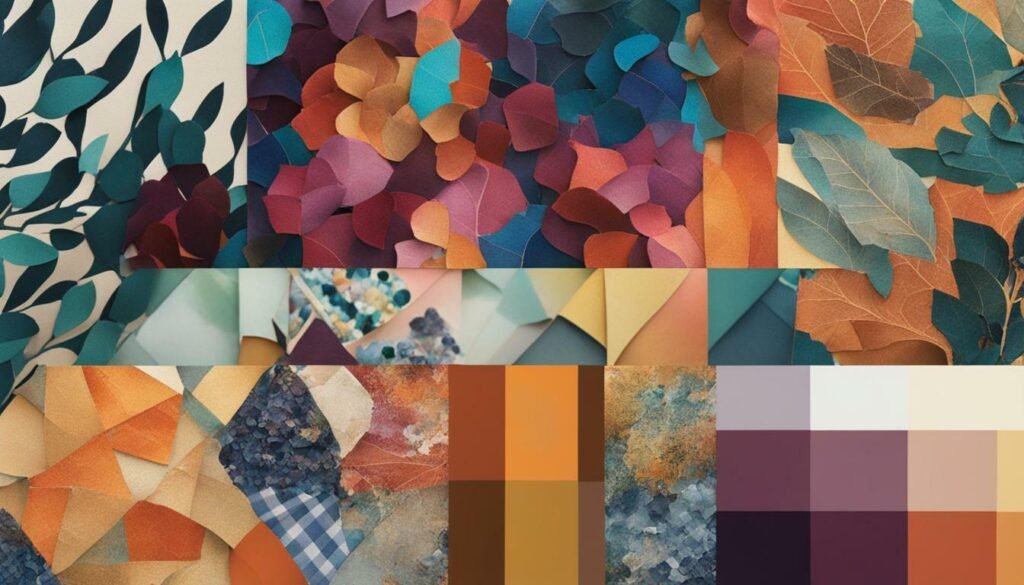
Typography can add a powerful visual element to your collages, whether it’s used to convey a specific message or simply as a design element. Here are some tips to help you incorporate typography seamlessly into your mixed media artwork:
- Choose fonts that complement your collage’s overall style and mood.
- Experiment with different text sizes, colors, and placements to find the right balance.
- Try printing text on specialty papers or using cutouts from magazines or newspapers.
- Use text as a storytelling element in your collage by incorporating words or phrases that add context or emotion.
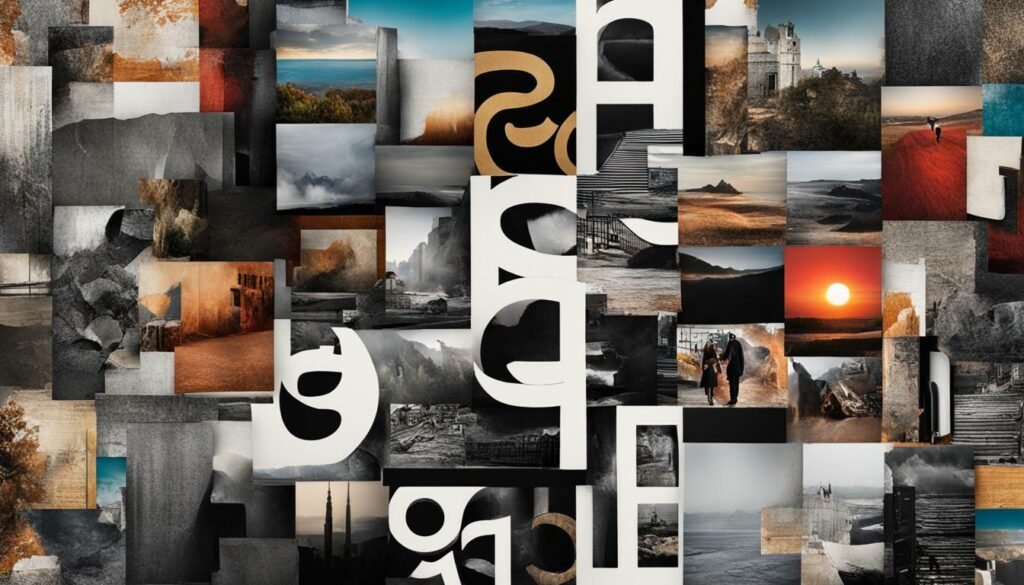
Including typography in your collages is just one way to enhance the visual storytelling of your artwork. Let your imagination run wild and experiment with various text elements to create truly unique and captivating pieces.
Exploring Found Objects
One of the most exciting aspects of creating collages is the ability to incorporate found objects, allowing you to repurpose everyday items and give them new life in your artwork. Upcycling and repurposing have become increasingly popular, and found object collage is the perfect way to jump on board with this eco-friendly trend. Here are some tips:
- Look for items with unique textures, colors, and shapes that can add interest and depth to your artwork.
- Consider repurposing items you find in nature, such as leaves, twigs, and stones, for an organic touch.
- Use old newspapers and magazines to find unique imagery and typography, while also reducing waste.
Remember, the possibilities are endless when it comes to found objects. Let your imagination run wild and experiment with incorporating a wide range of items into your artwork. Upcycling can also be an enjoyable way to connect with your community and reduce your environmental impact.
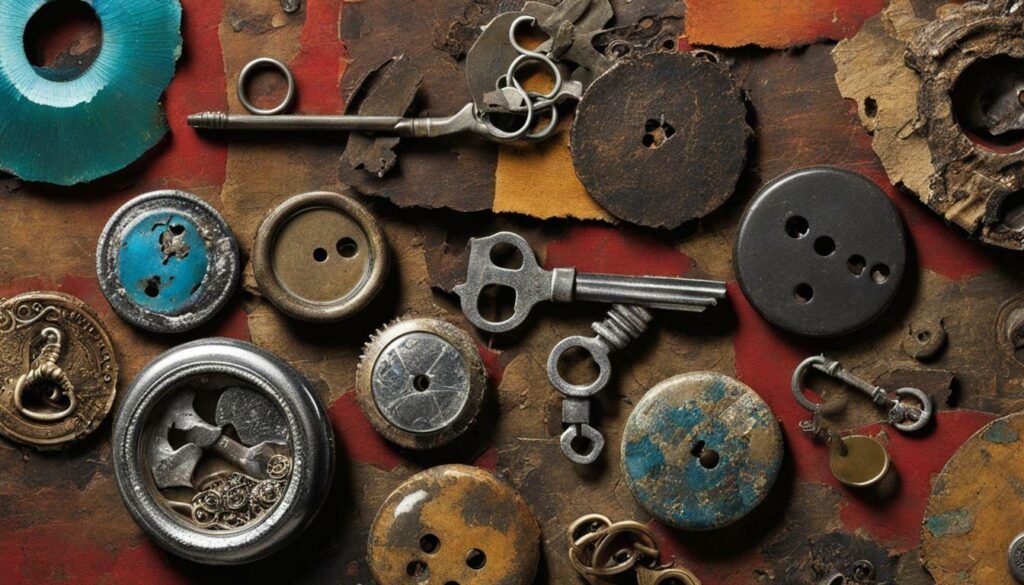
Digital Collage Techniques
In today’s digital age, it’s never been easier to create stunning mixed media collages with digital tools and online resources. Here are some digital collage techniques you can explore:
- Use graphic design software such as Adobe Photoshop or Canva to create a digital collage from scanned or photographed images.
- Experiment with different filters and effects to enhance the look and feel of your digital collages.
- Combine traditional cut-and-paste techniques with digital manipulation to create a unique and personalized artwork.
- Explore online resources, such as free stock photo websites, to find high-quality images to incorporate into your digital collages.
By combining traditional and digital techniques, you can take your collage art to new creative heights and explore endless possibilities. Remember to have fun and experiment with different techniques to find your unique style.
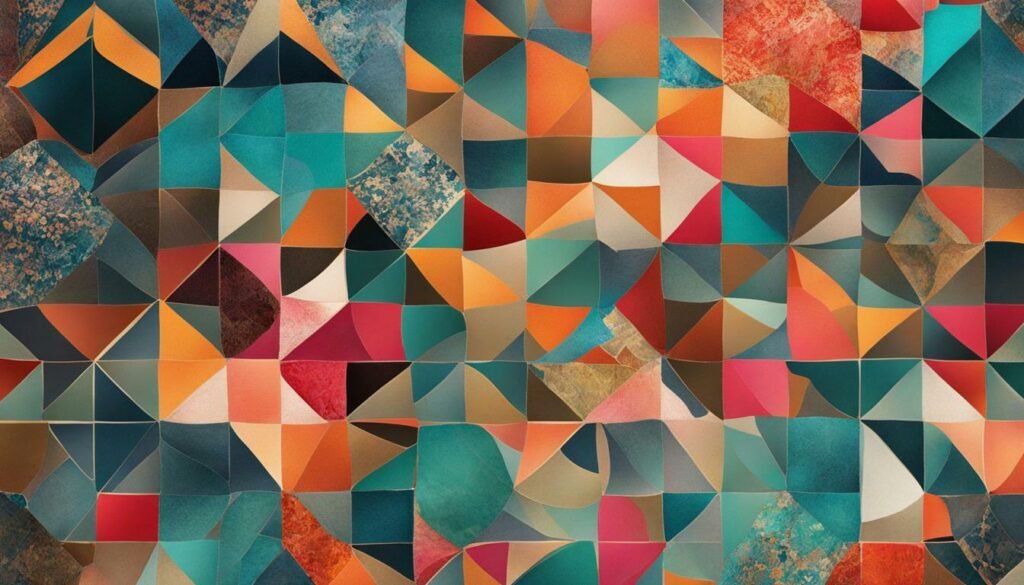
Collage art provides endless opportunities for incorporating other artistic mediums. Mixing in other materials can take your artwork to new creative heights and really make it stand out. Here are some mixed media techniques you can use to enhance your collages:
- Painting: Adding paint to your collage can bring color and depth to your piece. You can use acrylic, watercolor, or even oil paints.
- Drawing: Incorporating drawing or sketching into your collage can add a personal touch and further express your creativity.
- Printmaking: Using printmaking techniques, such as linocut or screen printing, can create interesting textures and patterns.
- Collage Embellishments: Adding embellishments, like beads, buttons, or sequins, can make your artwork pop and add a three-dimensional element.
Don’t be afraid to experiment and try new things when it comes to mixed media in your collages. The possibilities are endless, and you never know what kind of creative possibilities you’ll discover.
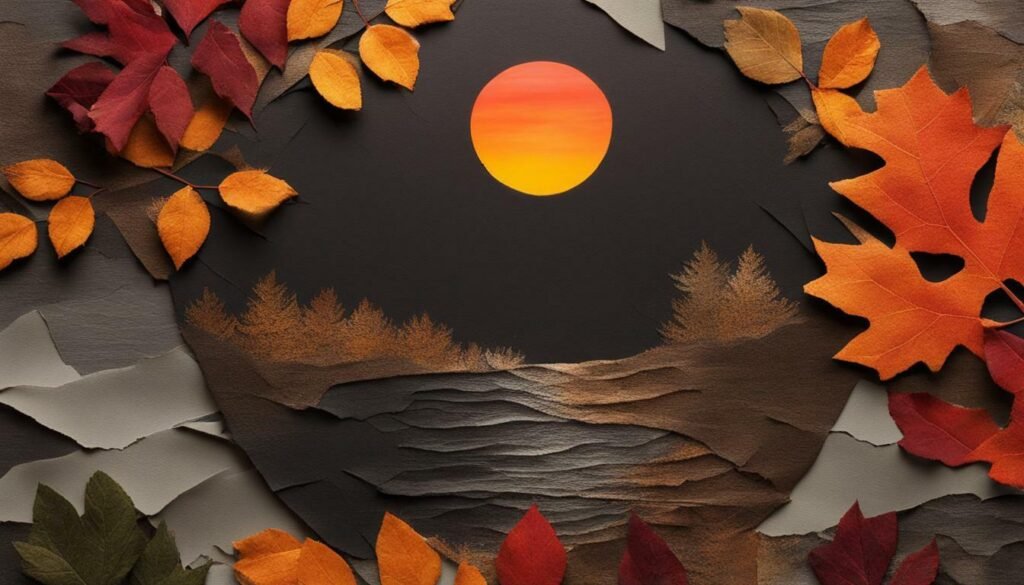
Tips for Displaying and Preserving Collages
Now that you’ve completed your masterpiece, it’s important to know how to properly display and preserve your collage. Follow these tips to ensure that your artwork remains in pristine condition and can be enjoyed for years to come:
- Consider framing your collage with acid-free matting and UV-protective glass to prevent fading and damage from light exposure.
- Choose a display location that is dry and free from direct sunlight, moisture, and extreme temperatures.
- If you prefer not to frame your collage, you can mount it on a sturdy backing board and hang it using specialized hooks or adhesives.
- Handle your collage with clean hands and avoid touching it with bare fingers to prevent oil transfer and smudging.
- For long-term preservation, consider storing your collage in a protective acid-free sleeve or portfolio.
By taking the time to properly preserve and display your collage, you can ensure that it remains a beautiful and cherished work of art for years to come.
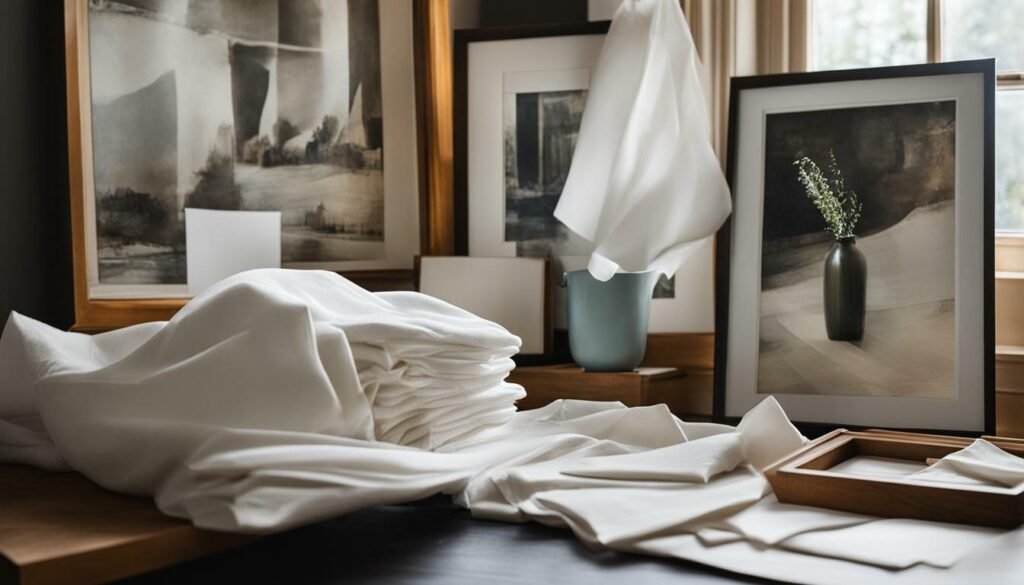
Collage art is an incredibly versatile medium that can be inspired by just about anything. Here are some tips to help you find inspiration and develop your personal style:
- Draw inspiration from your surroundings, whether it’s the colors and textures of nature or the patterns and shapes in urban landscapes.
- Experiment with different materials and techniques to unlock your creativity and find what speaks to you.
- Look to other artists for inspiration while staying true to your own unique style and vision.
- Practice regularly to develop your skills and refine your technique.
- Don’t be afraid to step outside your comfort zone and try new things to discover your artistic voice.
- Remember that collage art is all about expressing yourself, so embrace your personal style and let your creativity shine.
FAQ
What is Collage Art?
Collage art involves combining different materials, such as photographs, magazine cutouts, fabric, and found objects, to create a unique visual composition. It is a form of mixed media that allows artists to experiment and express their creativity in new and exciting ways.
What are the essential tools for Collage Art?
To get started with collage art, you’ll need a few essential tools and materials. These may include scissors, glue or adhesive, a cutting mat, a variety of papers, fabrics, and any other items you want to incorporate into your artwork. Having these supplies ready will ensure a smooth and enjoyable creative process.
What are some different techniques I can explore in collage art?
There are numerous techniques you can explore in collage art. From traditional cut-and-paste methods to more experimental approaches, the possibilities are endless. We’ll guide you through various techniques, such as layering, decoupage, photo transfers, and digital manipulation, allowing you to find your own unique style.
How can I create a visually pleasing collage composition?
Creating a visually pleasing collage requires attention to composition and layout. We’ll share valuable tips on how to arrange your elements to achieve balance and harmony in your artwork. Whether you prefer a symmetrical or asymmetrical design, understanding the principles of composition will elevate your collage art.
How can I add texture and dimension to my collage art?
Texture and dimension can bring your collage art to life. Discover techniques to incorporate various materials and textures into your artwork, such as using fabric, thread, or textured papers. Learn how to build layers and create depth, adding a tactile element that engages the viewer’s senses.
How can I use color effectively in my collage art?
Understanding color theory is crucial in any form of art. We’ll explore the fundamentals of color, such as the color wheel, complementary colors, and color psychology, to help you create visually impactful collages. Discover how different color combinations can evoke specific moods and enhance the overall message of your artwork.
How can I incorporate typography into my collage art?
Typography can add an extra layer of meaning and visual interest to your collages. Whether you want to convey a specific message or use text as a design element, we’ll show you how to incorporate typography seamlessly into your mixed media artwork.
How can I incorporate found objects into my collage art?
One of the unique aspects of collage art is the ability to incorporate found objects. We’ll guide you through the exciting world of found object collage, where you can repurpose everyday items and give them new life in your artwork. Discover how to transform ordinary objects into extraordinary compositions.
How can I create digital collages?
With the advancement of technology, digital collage has become a popular medium. We’ll introduce you to the world of digital collage techniques, including software recommendations and online resources. Learn how to combine traditional and digital methods to create stunning mixed media collages.
How can I enhance my collages with mixed media?
Collage art provides endless opportunities for incorporating other artistic mediums. We’ll explore various mixed media techniques, such as painting, drawing, and printmaking, to enhance your collages and take them to new creative heights. Discover the joy of combining different mediums to create truly unique and captivating artwork.
How can I properly display and preserve my collages?
Once you’ve completed your collage masterpiece, it’s important to know how to properly display and preserve it. We’ll share expert tips on framing options, mounting techniques, and preservation methods to ensure that your artwork remains in pristine condition and can be enjoyed for years to come.
How can I find inspiration for my collage art?
Finally, we’ll provide guidance on finding inspiration for your collage art and encourage you to explore your unique style. Discover how to tap into your creativity, overcome creative blocks, and continue evolving as an artist. Let your imagination soar and unleash the full potential of your collage artistry.
